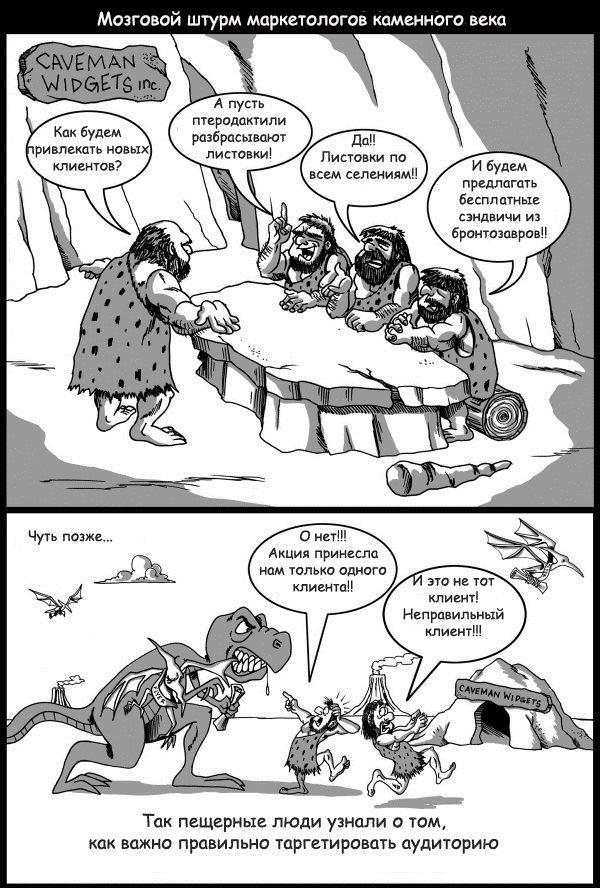Segmentation of the target audience for contextual advertising: a step-by-step example

Imagine what you are looking for in Yandex-Google phone case, and you are shown advertising polycarbonate. Slip with the audience in context - money down the drain.
In order not to “heat space” with your budgets, look at a simple scheme for identifying the needs and segmentation of the target audience in contextual advertising.
When preparing new RoKs, it will allow you to create high-conversion ads, and in existing campaigns, expand your reach and reduce the cost of a click.
')
How to segment a target audience
For market segmentation as a whole, the method of 5W, five questions is usually used.
Drinking water sample:

Image source
In contextual advertising, you can select the type of product + segments by gender and age of the audience. Thus, we get answers to 2 questions - “What we sell” and “To whom we sell”. Type of consumer know at least in general terms (male-female, what age). Plus, from which devices they go through the ads (desktop, mobile).
What does this give? Suppose we sell dresses for women 40-50 years. Accordingly, we do not need men and young girls. Bets for impressions are lower for them, and higher for the target group in order to stay ahead of the competition. As a result, the majority of transitions will be precisely from women of the required age.
An example of the settings of the campaign in Yandex Direct:

“Where?” Is the geography of impressions + type of device. “When?” - the situation in which users should see our ad is too complicated mechanics, which we will leave aside.
But the question "Why, for what purpose can the user search for our product?" Can be answered quite accurately. To do this, you do not need to order expensive marketing research, but just analyze the semantics - the search queries for which visitors come to your site.
For example, take the advertising campaign of a fitness center. In the beginning we will define to whom and what we sell. To help you, we recommend drawing a mindmap (mind map). So you can clearly see the target groups and their needs:

In the structure, we limited ourselves to the basic parameters in order to show the principle itself. Of course, you can have much more types of products, target groups and decision motives.
The first level is the types of services. What we sell: strength training, aerobic exercises and martial arts (boxing, aikido, wushu, etc.).
The second level is the target groups. Girls and men in each case.
And the last level - situations where a person from the target group can use your services. The reason why he can buy something from you. Here we have identified from three to five needs, and in general the task is to paint as much as possible the motivation of the audience. This allows you to do not generalized, but precise segmentation.
For example, not just a visitor to aerobic classes, but young moms with the aim of restoring the figure after giving birth. Young people who need to hit the girls pumped figure to the summer and so on.
Traffic segmentation
Exact consumer portraits by themselves do not give anything. All the "salt" is to create value propositions for them in the ads and on the landing page. Personalization = high conversion. But first, let's work with semantics.
In the process of preparing the material, we analyzed with the help of the Spywords service advertising campaigns of four leading fitness clubs in the region, and we saw that they merge 96% of the traffic by targeted requests:
- The name of the object ("fitness club", "gym", etc.);
- The name of the service ("strength training", "fitness club", "wushu");
- The price of the issue ("fitness is inexpensive", "fitness shares");
- Geography + competitors ("fitness club Perm", "Planet Fitness");
- Apsails goods (gloves, sports nutrition, etc.)
The right column Yandex Wordstat taxis)

This is “hot” traffic with a good hit in Central Asia. At the same time he has 2 minuses:
1) Expensive;
2) Not enough.
400-500 direct requests will be typed in, with a cost per click of up to 300 rubles (Perm Region):

Let's go back to the target group map. As an example, take men with the need to build muscle mass.
We write out the main situations when a man needs to be “pumped up”:
- Sportsman. Participates in bodybuilding and powerlifting competitions;
- lover. Just be fit;
- Don Juan. Wants to impress a girl.
And now the requests for which they are looking for a solution.
- Athlete - “Powerlifting Norms”, “Deadlift”, “Bench Press”, etc .;
- Amateur - "How to pump your biceps," "Training for weight loss," "Exercises for the press," etc .;
This is “warm” traffic - queries on the topic, while they are non-commercial in nature. The user has no purpose to buy something. He simply searches for information, chooses between exercises at home, classes at a club, or some protein supplements.
In the latter case, this is simply a statement of the problem:
- Don Juan - “How to make an impression on a girl”, “How to please women”, “How to look macho”, etc.
Here is “cold” traffic, when the user does not think directly about our proposal to go to the gym as a way to please the girls.
Of course, these are just a few examples. Near-target requests are a sea of cheap traffic, where almost no one is advertised. How to find them?
First, through the same Yandex Wordstat:

Secondly, we look at the hint “We are looking for this request”:

To simplify the process, use programs - parsers of key phrases (Key Kollector, SlovoEb, etc.). Feed the parser several options, and it will give out several thousand keywords. Yes, they will have to "sift" for garbage phrases and microparticles, but the result is worth it.
The cost of a click is at least several times, and about ten times less than targeted requests.
Instead of conclusion
If you simplify the scheme, then you should have answers to three questions:
1) Who is your visitor?
2) Why did he come?
3) At what stage of proximity to the purchase is it?
Otherwise: Target group → Reasons to buy → Willingness to buy.
PS In the next article we will discuss how to create value propositions in ads and on landing pages for the specific needs of the audience + how to “warm up” cold traffic.
Analyze your audience and do not repeat the mistakes of primitive marketers)

PPS Share your experience, ask questions in the comments on the use of methods in your business.
 The author of the material is Alexander Alimov, the founder of YAGLA.ru, an expert in the field of traffic hypersegmentation
The author of the material is Alexander Alimov, the founder of YAGLA.ru, an expert in the field of traffic hypersegmentationSource: https://habr.com/ru/post/299636/
All Articles